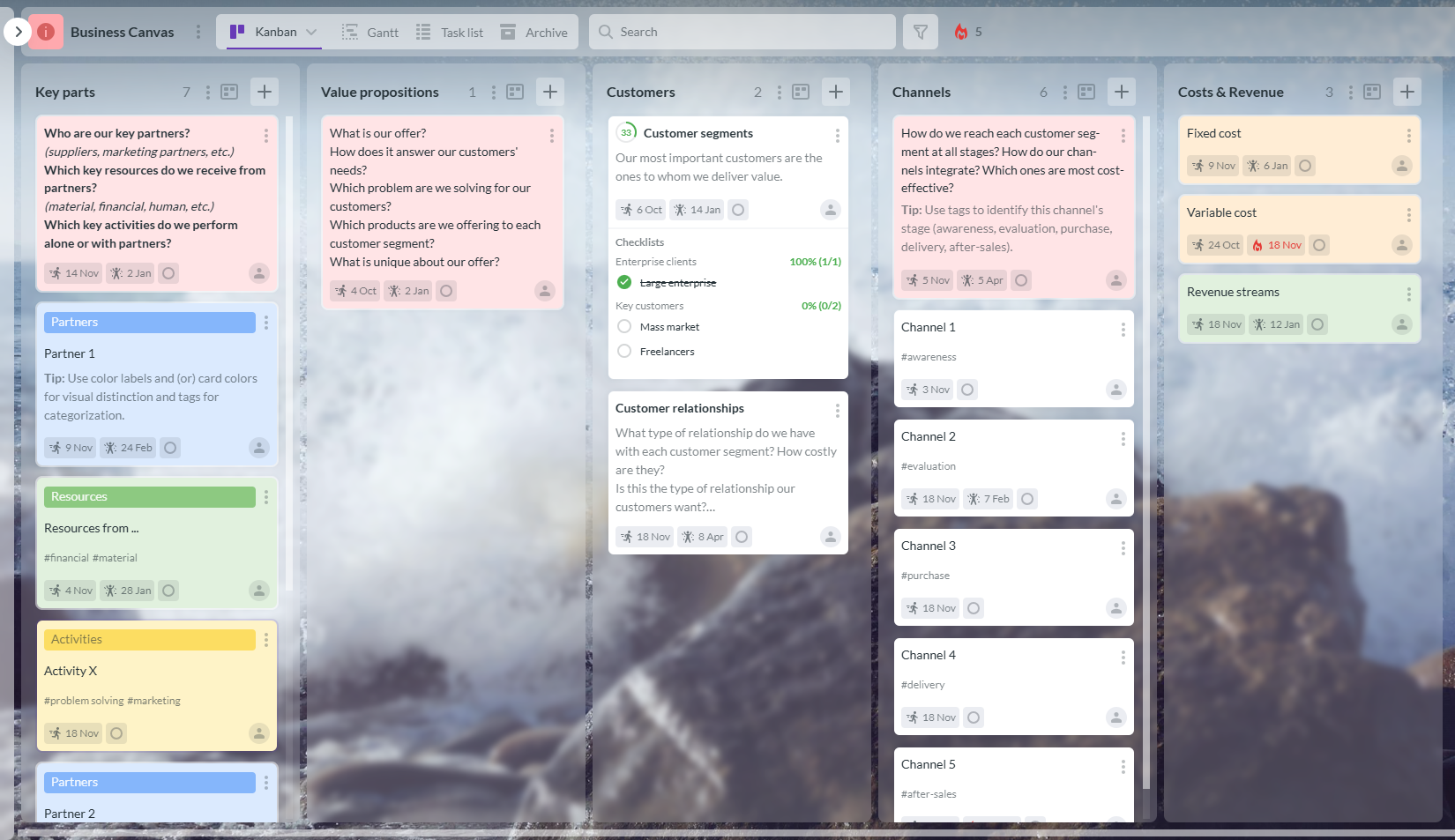In this Article:
Try Kanbanchi now
Start your free trial

There are some projects that sail smoothly from start to finish, with happy clients and sometimes even delivered under budget. Then there are ‘those’ projects that are chaos from the start, with loads of missed deadlines and financial headaches. What’s the difference? Well, it often boils down to one simple factor: not sticking to the established project management best practices.
These best practices are not just academic theories, written by bored profs with nothing better to do; they’re actually the distillation of years of:
Often, from the completion of hundreds of other successful projects. They provide a standardized roadmap that’ll help:
Today, teams often work remotely worldwide, and project demands change constantly. It means that guesswork is a direct path to project failure.
To achieve business success, you must first master project management best practices, which underpin project execution.
Don’t know where to start? We’ve got you. Kanbanchi’s comprehensive guide will walk you through these principles, from planning through to key risk management and performance monitoring techniques.
We’ll also show you how Kanbanchi, the intuitive project management tool built for Google Workspace, is the perfect go-to solution for all of this. So, ask yourself: are you ready to move beyond managing tasks to truly master project delivery?
Let’s transform your project approach today, so you can win in the future.

Effective project management planning sets the foundation for successful execution and delivery.
The foundations of every successful project are laid long before the first task begins. The initial project management best-practice phase, the planning stage, is where tasks are laid out, risks are identified, and everyone gets to know what their role is. It’s a critical stage, as a lack of clarity here will often lead to mess-ups later on.
A project with no clearly defined goals is directionless; guaranteed to miss its destination. A critical step in planning is establishing objectives that everyone, from the team member executing the task to the CEO or ultimate stakeholder, can understand and agree upon.
The widely adopted best practice uses the SMART framework to define these goals:
By rigorously applying the SMART framework, you can set goals, steer the team toward them, and deliver consistent results.
Once goals are set, you need a document that serves as a blueprint for the project lifecycle: usually called the Project Plan. The document should be formally approved and distributed before execution begins.
Key components of the Project Plan include:
This document establishes the initial contract for the project, setting the stage for all parties and outlining how expectations will be managed going forward.
One of the most essential project management best practices for mitigating complexity is creating a Work Breakdown Structure (WBS). This is a hierarchical overview of the project scope and deliverables.
The WBS is crucial because:
A WBS should be designed around deliverables, not actions, to make it clear what the project is creating at each level.
The baseline, often referred to at the Scope, Schedule and Cost, is arguably the most fundamental concept in modern project control. It is the snapshot of your approved plan. The original definition of the project’s reach, timeline, and budget. All subsequent performance is measured against this:
This acts as the reference point for project control. If your current schedule deviates from the baseline, you can immediately identify the issues and take action.
Without a clear baseline, monitoring progress is impossible, turning project tracking into mere guesswork.
Scope creep (that is to say, the uncontrolled expansion of project scope without adjustments to time, cost, or resources) is the primary killer of projects. The best practice for project management here is to implement a rigid Change Control process.
A change control system ensures that:
By ensuring that change is managed formally, not through informal conversations, you protect the project’s integrity and avoid the deadly trap of doing ‘a little extra work’ that turns into months of delays.

Project management best practices in methodologies help teams choose the right approach for efficient and successful project delivery.
No single framework works for every scenario. A core project management best practice is to select and adapt a methodology that fits the project environment, complexity, and client requirements. Understanding the distinctions between the major approaches is essential for modern PMs.
The Waterfall methodology is a linear, sequential approach in which each phase:
Must be completed and approved before the next phase can begin.
Best for: Projects with stable, well-defined requirements, little expected change, and a clear, predictable end goal (e.g., manufacturing, simple construction).
Key Strength: Provides maximum structure, detailed upfront documentation, and a clear sequence of activities.
Agile methodologies embrace flexibility and are designed for projects where requirements are likely to change or are initially unclear, for instance, in software development, R&D, and product marketing.
Increasingly, best-practice project management methodologies use hybrid models that combine the structure of Waterfall with the flexibility of Agile.
For most modern teams, Kanban has become a near-universal best practice. Its simplicity and clarity cut through organizational noise.
By visually representing the workflow on a board, Kanban allows teams to:
This technique is foundational to improving efficiency and reducing delays during the crucial execution phase.
To expand your knowledge, we also recommend checking out other articles on our blog:
11 Principles of Project Management to Guide Your Project to Success
5 Project Management Examples for Project Success
The execution phase is where the most value (and the most risk) resides. To keep execution predictable and successful, three major project management best practises must be rigorously applied: risk control, clear communication, and defined accountability.
Risk is inherent in every project. Successful Project Managers don’t ignore it; they treat risk management as an ongoing, proactive exercise with three core steps at its heart:
All identified risks, their owners, and their response plans must be documented in a living Risk Log that is reviewed weekly.
The most effective best practice project management techniques for risk, require assigning clear ownership. Each logged risk must have a designated Risk Owner responsible for monitoring its status and executing the response plan if the risk materializes into an issue.
The Risk Log serves as the project’s collective memory of potential danger. By making it accessible and transparent, Project Managers can easily escalate high-priority items to the Project Sponsor, ensuring that governance is informed and corrective action is timely.
Poor communication is cited as a leading cause of project failure. A best practice communication strategy is tailored to each project, consistent, and transparent.
Role clarity is a pillar of execution. When responsibility is fuzzy, tasks get delayed or duplicated. Best practice is to implement an accountability matrix such as RACI (Responsible, Accountable, Consulted, Informed).
The key principle of RACI is that every key decision and deliverable must have exactly one Accountable person. This single point of ownership ensures decisions are made efficiently and that a single person holds the ultimate sign-off authority.
Accountability requires continuous check-ins because it isn’t just about assigning tasks; it’s about having a system to track progress on those assignments. This leads directly to the need for clear performance monitoring.

Kanbanchi helps teams implement project management best practices by visualizing workflows and managing tasks effectively.
The abstract principles of project management best practice are brought to life through practical tools. Kanbanchi is designed to help Google Workspace teams seamlessly implement all the principles we’ve discussed so far, in our guide: from WBS creation to transparent reporting.
Kanbanchi eliminates the friction points that often prevent teams from following best practices. How? By integrating all required views into one unified platform.
The added bonus is that there’s no learning curve either. If you’re familiar with Google Workspace already, you’ll find Kanbanchi easy to get to grips with from the start.
Here’s what it can offer you:
Kanbanchi allows users to instantly switch a visual Kanban board to a full Gantt chart. This feature automatically converts the structured lists of your Kanban board into the hierarchical Work Breakdown Structure required for formal planning.
Teams can use the Kanban view to manage day-to-day workflow, enforce WIP limits, and maintain continuous flow, the core of Agile best practices. The immediate visual status tracking inherent in Kanban ensures constant transparency.
Kanbanchi cards serve as the single source of truth for all deliverables. Team members are assigned as the Responsible party, and custom fields can be added to clearly designate the Accountable person, effectively implementing the RACI model within the workflow.
Since Kanbanchi is stored in Google Drive, documentation is always centrally linked to the relevant tasks. Furthermore, Kanbanchi’s alerts integrate with Gmail, ensuring timely communication and documentation.
If your business is ready to make project management central to success, you need the best tools. Kanbanchi offers intuitive software with no learning curve and it integrates with your existing business systems. Get in touch with us today, and let’s get a conversation started.
Try Kanbanchi Free Today for project management solutions that make a real difference
We’ll round off our guide with some commonly asked questions about project management best practices.
Yes, they are considered best practice project management techniques because they provide essential visualization.
Gantt charts are a best practice for timeline planning and dependency management. At the same time, Kanban boards are a best practice for visualizing workflow, managing flow, and limiting work in progress (WIP) during execution. The best practice is often to use them together and take a hybrid approach.
While many are critical, arguably the most important foundational principle is Scope Definition and Control. Having a clearly defined scope (documented in the Project Charter and WBS) and a rigorous Change Control process prevents scope creep, the leading cause of project failure and budget overruns.
Kanbanchi directly supports the Work Breakdown Structure (WBS) by allowing users to switch the task list in the Gantt chart view into a hierarchical structure. This allows managers to organize tasks by phase and deliverable, ensuring 100% of the scope is captured and visually represented, which is key to effective planning.
The core best practice project management principles (clear goals, risk management, stakeholder communication) remain constant regardless of the methodology. However, the techniques differ. Waterfall emphasizes upfront, detailed planning and adherence to baselines, while Agile emphasizes continuous feedback, iteration, and adaptation to change.
Absolutely. Best practice risk management includes identifying positive risks (opportunities). Just as you plan to mitigate threats, you should plan to maximize the potential impact of opportunities (e.g., accelerating a schedule or reducing costs) through strategies like Exploiting or Enhancing the opportunity.
In this Article:
Start using Kanbanchi now
Start your free trial